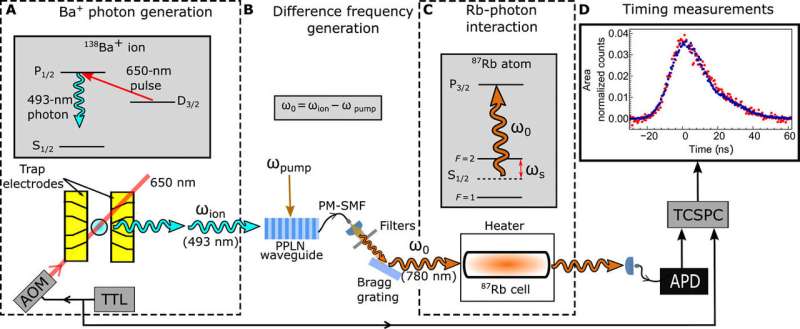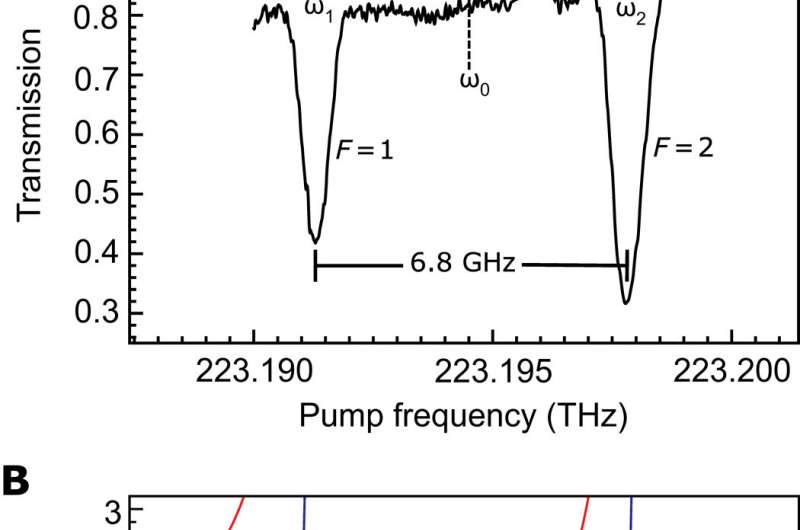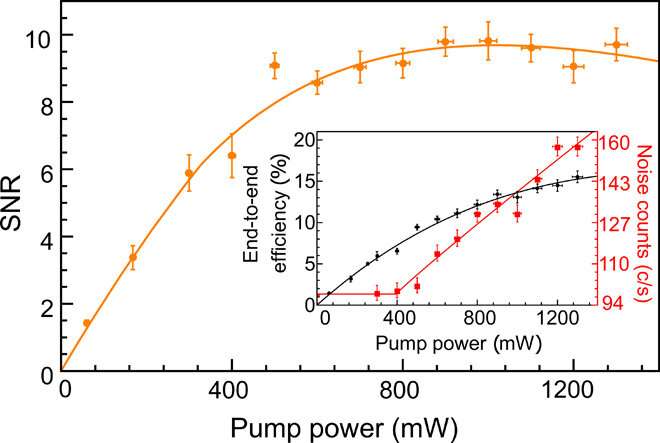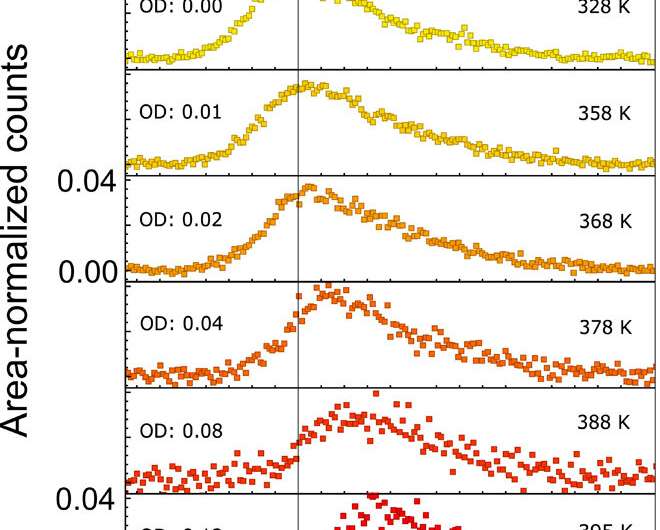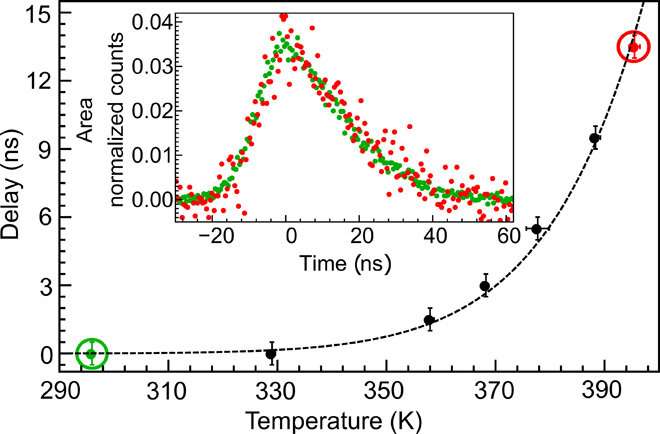Experimental schematic of photon production from a 138Ba+ ion, QFC, and photonic slowing in a warm neutral 87Rb vapor. (A) The energy levels of 138Ba+ and schematic showing the ion confined in a segmented blade trap. A TTL pulse-activated AOM controls a 650-nm excitation light. (B) The QFC setup including a PPLN waveguide. Converted light, ω0, is at the difference frequency between photons emitted from the ion at ωion and pump photons at ωpump. The output of the PPLN is fiber coupled to a polarization maintaining single-mode fiber (PM-SMF). A series of filters and a Bragg grating filter out pump light and unconverted 493-nm light, which reduces the amount of anti-Stokes noise. (C) A 87Rb energy level diagram and a vapor cell housed inside a heater through which converted single photons pass. (D) Photons are detected on an APD, and a TCSPC collects the arrival time of the photons with respect to the TTL sent to the AOM. As an example, single-photon temporal shapes at 493 nm (blue circles) and frequency-converted photons after passing through the cell at room temperature (red circles) are shown. Credit: Science Advances, doi: 10.1126/sciadv.aav4651
Quantum networks can be practically implemented to interface with different quantum systems. In order to photonically link hybrid systems with combined unique properties of each constituent system, scientists must integrate sources with the same photon emission wavelength. For instance, trapped ions and neutral atoms can both have compelling properties as nodes and memories within quantum networks but without photonic linking due to their vastly different operating wavelengths. In a recent report on Science Advances, J.D. Siverns and colleagues at the Joint Quantum Institute, Department of Physics and the Army Research Laboratory in the U.S. demonstrated the first interaction between neutral atoms and photons emitted from a single trapped ion.
To accomplish this, they used Rubidium (87Rb) vapor to delay the origin of photons from a trapped Barium (138 Ba+) ion by up to 13.5 ± 0.5 nanoseconds (ns). The researchers used quantum frequency conversion (QFC) to overcome the frequency difference between the ion and neutral atoms during the process. They tuned the delay and preserved the temporal profile of the photons and delivered the results as a hybrid photonic interface with applications as a synchronization tool critical for large-scale quantum networks in the future.
To establish scalable quantum networks, physicists must integrate disparate quantum components. Researchers had previously linked photonic quantum systems to form hybrid platforms with single atoms, Bose-Einstein condensates, solid-state systems, atomic vapors and atomic ensembles. Progress in hybrid networking is typically focused on cases where the native photon wavelength of each system is the same by definition, or via direct engineering of the photon source itself. In a practical network, such strict requirements are unlikely to be achieved, since photons emitted from existing devices in quantum communication technologies vary across a wide photon spectrum. To avoid spectral mismatch, researchers can introduce quantum frequency conversion (QFC) to convert a photon's frequency to another frequency while preserving its quantum properties. A hybrid system that combines the desirable features of different components can help realize a viable quantum networking tool.
Absorption, refractive index, and group velocity within a warm 87Rb vapor. (A) Absorption profile of the 87Rb D2 line using 780 nm obtained via QFC from a 493-nm laser light with the cell at room temperature. The pump laser’s mode-hop-free tuning range limits the frequency tuning range. The refractive index (B) and group velocity (C) in the vicinity of the two absorption peaks as a function of detuning from peak transmission, δ, at 373 K (blue) and 423 K (red). DFG; difference frequency generation. Credit: Science Advances, doi: 10.1126/sciadv.aav4651
Trapped ions are strong candidates for communication nodes due to their long qubit lifetime as well as high-fidelity ion-photon entanglement. Neutral atoms are versatile quantum systems useful as memories, photon storage media or for tunable photon delay by slowing light. Investing in the design, control and development of trapped ion and neutral quantum technologies have yielded remarkable progress in quantum networking, computing, metrology and simulation. Researchers commonly use neutral atom vapors and magneto-optically trapped atoms as slow-light media for pulses of light or for single photons. Slowing light for tunable photonic delays is useful for photon synchronization to implement network protocols using photonic interference. In the present work, Siverns et al. demonstrated the first interaction between neutral atoms and photons emitted by an ion by slowing the photons generated from a single trapped ion within a neutral atom vapor.
To create a medium with low group velocity for slow light propagation within atomic vapors, the research team used photons with a frequency between two absorption resonances of a medium. They investigated the two absorption resonances using electromagnetically induced transparency (EIT) or far-off resonance. Siverns et al. used two D2 absorption resonances established via hyperfine ground state splitting of 87Rb with a less complex experimental setup compared to EIT methods, which only required single photons at the correct frequency. The researchers then derived the group velocity of the photons emitted from Ba+ ions after QFC (quantum frequency conversion). They tuned the photon's optical frequency to achieve a maximum in transmission and greatly reduced group velocity. Siverns et al. tuned the photon delay by changing the atomic number density (N).
Signal-to-noise-ratio (SNR) measured after filtering of the frequency-converted ion signal. The orange curve is the SNR given the measured conversion efficiencies and noise at each pump power. Inset: Measured conversion efficiency (black) and measured noise counts (red) on the APD as a function of pump power. The black curve is a theoretical fit to the efficiency data, and the red curve is an empirical fit to the noise. Credit: Science Advances, doi: 10.1126/sciadv.aav4651
As the source of the 493-nm single photons, the research team used 138Ba+ ions, which they trapped by applying voltages to segmented blades housed in an ultrahigh vacuum chamber. They collected the photons using a 0.4 numerical aperture (NA) lens; fiber coupled them and sent them to the QFC setup. The research team coupled the photons of a specific frequency with a pump laser to form a different frequency near 1343 nm, which they coupled into a periodically poled lithium niobate (PPLN) waveguide for difference frequency generation (DFG). After frequency tuning the pump laser, the team produced 780-nm photons with a frequency between two optical absorption resonances to implement slow light. The scientists showed the conversion efficiency of the PPLN device as a function of the pump power coupled into the waveguide.
Area-normalized temporal photon shapes. Area-normalized temporal shapes of frequency-converted photons that have passed through a warm 87Rb vapor cell. The 87Rb vapor cell temperature is set to the values indicated. The optical density (OD) of the warm vapor is stated for each temperature, at a frequency ω0, and using the same atomic density, N. Credit: Science Advances, doi: 10.1126/sciadv.aav4651
Siverns et al. maximized the signal-to-noise ratio (SNR) of the converted light instead of using the total amount of converted light. They converted the 493-nm photons using DFG (difference frequency generation) to tune the pump optical frequency. The scientists coupled the output of the PPLN to an 800-nm single-mode fiber to capture 780-nm photons and spatially filtered the other modes away. Upon filtering the photons, the research team sent them through a 75-mm long heated glass cell filled with enriched 87Rb, which they detected using an avalanche photodiode (APD). When the photons passed through the rubidium cell at room temperature, their absorption and scattering decreased the signal-to-noise ratio to ~6. To measure the temporal shape, they recorded the arrival time of the photons at the APD, relative to the 650-nm excitation acoustic-optic modulator (AOM) and transistor-transistor logic (TTL) pulse with a time-correlated, single-photon counter at a resolution of 512 picoseconds (ps). With increased atomic density of the vapor cell, the SNR monotonically decreased to approach ~1 at 395 K. Despite lower SNR, the photon delays remained clearly visible.
The research team determined the photon delay by temporally shifting each delayed photon to overlap with a photon shape at room temperature. The scientists noted the photons emitted by the Ba+ ion and the drift of the pump laser to impact the stability of the optical frequency of the converted photons. They aim to increase photon delays and improve transmission by increasing the nonlinear refractive index in the vapor using advanced methods such as EIT (electromagnetically induced transparency) in the future.
Delay of the frequency-converted photons emitted from the trapped Ba+ ion after passing through a 87Rb vapor cell as a function of the cell’s temperature. The dashed theory curve is a scaled version of the equation derived in the work to account for N. The temperature and delay error bars are due to temperature fluctuations over the course of the experiment and the bin width of the histogram photon arrival time data, respectively. Inset: Overlap of temporal shapes of photons transmitted through a 296-K room temperature cell (green circles) and a 395-K cell (red circles). The relative delay between the two traces has been removed to allow for comparison. Credit: Science Advances, doi: 10.1126/sciadv.aav4651
In this way, J.D. Siverns and colleagues demonstrated the first interactions of photons emitted from a trapped ion with a neutral atom system. They experimentally slowed the frequency-converted photons emitted from a trapped ion within a warm rubidium vapor cell. The team observed tunable delays of up to 13.5 ± 0.5 ns with negligible temperature dispersion of the photons. The research work facilitated an ideal system for use as a device to tunably synchronize remote quantum nodes in a hybrid quantum network.
The new approach will offer a path toward photonic quantum gates between remote ions and neutral atoms, where each system can independently emit photons of a comparable profile. The work will also pave the way for future quantum-state transfer between ions and neutral atoms to facilitate experimental, ion-neutral atom photonic entanglement distribution, and photonic storage of flying qubits emitted from trapped ions combined with existing, advanced atom technologies.
More information: J. D. Siverns et al. Demonstration of slow light in rubidium vapor using single photons from a trapped ion, Science Advances (2019). DOI: 10.1126/sciadv.aav4651
Petr Siyushev et al. Molecular photons interfaced with alkali atoms, Nature (2014). DOI: 10.1038/nature13191
Or Katz et al. Light storage for one second in room-temperature alkali vapor, Nature Communications (2018). DOI: 10.1038/s41467-018-04458-4
Han Zhang et al. Preparation and storage of frequency-uncorrelated entangled photons from cavity-enhanced spontaneous parametric downconversion, Nature Photonics (2011). DOI: 10.1038/nphoton.2011.213
Journal information: Science Advances , Nature , Nature Communications , Nature Photonics
Provided by Science X Network
© 2019 Science X Network
